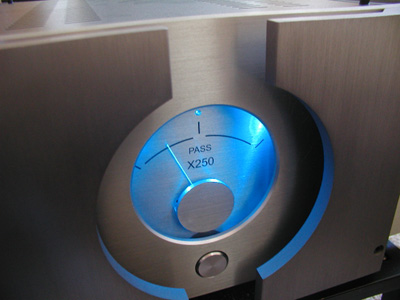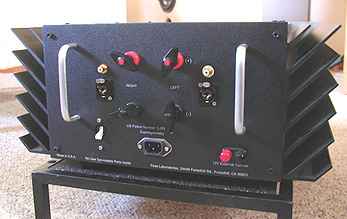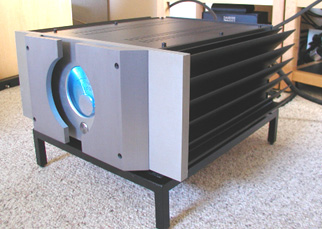You are reading the older HTML site
Positive Feedback ISSUE
4december/january 2003
X250 stereo amplifier
as reviewed by Art Shapiro

ART SHAPIRO'S SYSTEM LOUDSPEAKERS ELECTRONICS SOURCE CABLES ACCESSORIES
|
I thought this would be an easy review. After all, my big ESP Concert Grand speakers are known to be hostile toward solid state amplification. Perhaps it shouldn’t be so, as there are great and lackluster examples of both tube and solid state technologies, but experience and audio show encounters have proven that the ESPs are extremely partial toward tubes. That’s just the way it is. So, I was sure I’d be telling you that the substantial power of the Pass X250 amplifier gave the system an extra dose of the power and authority it deserves, but that I wouldn’t want to give up my current Music Reference amp.
As with so many other pursuits in life, boy, was I surprised! But I digress. First of all, the X250 is a gorgeous and physically imposing unit, both in size and its roughly 100-pound mass. The almost preposterously thick front panel has two protruding angular plates of similarly thick material, which envelop a large power meter. I assume these plates are to be used as front handles in conjunction with more traditional handles on the rear. Both sides of the unit serve as heat sinks for the amplifier, and I had no issues with heat during my time with the X250. It was probably not severely taxed driving the relatively efficient Concert Grands. The rear of the X250 has high-quality RCA input jacks, and perhaps the finest speaker binding posts I’ve encountered. No searching for the wrench for these guys—the posts have substantial, protruding, user-friendly flanges on which I could easily get plenty of clamping force via hand pressure. My internally bi-wired Cardas speaker cables have only one connection at the amplifier end, so I was not bothered by the single connection per side. I suspect that it’s so easy to get a superbly tight connection with these posts that those who need to clamp a pair of cables on each post will not be unhappy with the absence of a second pair of connectors.

I used the heavy-duty, apparently generic power cable that was provided with the amp, and plugged it into one of my two dedicated lines, using the other line for everything else, the CAT preamp in one receptacle and everything else through a Brickwall power conditioner in the second. As there was little choice but to place the X250 on the floor, my normal one-meter Monster Sigma M2K interconnects wouldn’t reach from the rack-mounted CAT, so I used a 1.5-meter pair of Van den Hul D102 III interconnects. I thought it fairest to not use my REL subwoofer during the review, as it has its own amplifier and thus would tend to obscure the Pass.
Turning on the large amplifier did not seem to cause an electrical outage in the neighborhood, and revealed an alluring soft blue sheen to the meter on the front panel. The amplifier exuded quality, and had a great physical "wow" factor. It isn’t cheap, and one glance reinforces that point rather quickly. There were absolutely no issues with turn-on or turn-off thumps or other noises, and there wasn’t the slightest trace of hum during my time with the amplifier. This further reinforced my impression that the X-250 is a superbly engineered product, and given that it will put out something like 500 watts per channel into my 4-ohm speakers, the last thing I wanted to worry about was having high-powered bursts of noise blasting through them. It was soon apparent that I had little cause for concern.
How did it sound? It didn’t take long for the X250 to stabilize and sound its best—after five or so minutes there was no evidence of sonic change—and what I heard was, for the most part, outstanding. First of all, as I expected from the significant wattage, there was a sense of power and sonic impact that was an absolute joy. Not overblown, not boomy, not peaky, just spectacularly appropriate. When deep notes at the bottom end of the piano keyboard were struck, sound reverberated through the room, portraying the might of a modern concert grand in a manner that would bring a smile to any music lover’s face. Take the famous Rachmaninoff C# minor Prelude, familiar to almost anyone by melody if not by name, with the three powerful descending bass notes that open the work. In my Conifer CD, A Rachmaninoff Portrait with Kathryn Stott performing, this grand opening phrase projected into the room with an intensity far more exciting and powerful than my own amplifier could hope to achieve. The deeply resonant sonority was right on. In the last third of this piece, notated mostly at triple and quadruple fortissimo markings, the system was producing torrents of precisely controlled sound. I want to emphasize how well the X250 could control my huge, multi-driver speakers. It wasn’t just the sense of power imparted by the large amplifier, but that the power was directed in a completely accurate and appropriate manner.
Ditto for large orchestral crescendos. I played the Reference Recordings CD entitled Exotic Dances from the Opera, concentrating on some of the more massive sections, and was consistently rewarded with that same effortless sensation of infinite power, once again under complete control. The loud brass instrumentation was beautifully portrayed without smearing or booming or any other negative characteristics I could discern. The system had never behaved so well.
I invariably turn to the John Rutter Requiem, also on Reference Recordings, to hear how ultra-low organ pedal notes are portrayed. One day, playing the Piu Jesu track, it occurred to me that it might be fairest to disconnect the subwoofer so as to assess how the Concert Grands were handling the low end of the organ by themselves. Then I realized, as I told you before, that the subwoofer was unattached, and that I was experiencing yet another marvelous example of the X250’s ability to control my speakers. It wasn’t that they were going deeper than they would with my Music Reference amplifier. Once again it was a matter of the huge Pass amplifier’s total control and mastery of the speakers.
Another area in which I was highly impressed was detail. Detail is a funny thing. Too much and one ends up with the audio sin of "etched" or "analytical" sound, the sonic equivalent of turning the brightness and tint up too far on a television. Too little and the music gets blurry and indistinct, as with some of older pieces of tubed equipment. There is some finite range of detail that is in some sense reasonable, and the X250 unquestionably fell within that area. It was more detailed than my freshly retubed RM9, and I appreciated the manner in which the X250 appropriately nailed this characteristic. Take some of the hair-raising piano pyrotechnics exhibited by Earl Wild on the Sony CD entitled The Romantic Master. As reasonably as they are presented through my own amplifier, I could hear more of the incredible keyboard gymnastics through the X250. And I can’t stress enough that this was never over the top, never too detailed, never excessive and fatiguing. I was highly impressed by the X250’s ability to resolve the most complex piano passages in a totally musical manner. This superior presentation carried forth into orchestral performances as well. In highly complex pieces such as the big Stravinsky ballets, The Rite of Spring and Petroushka, with multiple simultaneous themes and sub-themes, I couldn’t fail to be impressed with the clarity of the X250, which enabled me to enjoy the intricacies of the music without the performances crossing the line into sterility. Music through the Pass was like a window into the soul.
I also have to rave about the ability of the X250 to precisely localize sonic images. Spatial aspects of music, so critical to many audiophiles, are normally something to which I am almost totally oblivious, both in my audio system and at live performances. While others wax poetic at length about soundstaging and image width, height, and depth, this characteristic is rarely something I can sense, and a system has to be quite bad or quite good before spatial issues register in my consciousness. Well, the X250 rates extremely highly in this area. I was unusually aware of the precise location of instruments in the listening space, and my fellow reviewer Mark Katz, visiting during several of the listening sessions, confirmed that I wasn’t just pulling this out of—forgive me—thin air. On a Swedish Society vocal/piano recital entitled Solveig’s Sang, sung by soprano Solveig Faringer, I was able to locate the vocalist and the piano with far more accuracy and ease than through most equipment, mine included. It was also obvious that the Pass amplifier was throwing a huge and deep soundstage on orchestral performances where this was appropriate.
Alas for me, there was one area in which the X250 could not equal the standard set by my Music Reference amplifier, and it is a significant shortcoming. Perhaps it’s the converse of the detail that the X250 was presenting so appropriately, but I was consistently bothered by an absence of musical subtlety, meaning the bloom around the notes and the general ambience that great tubed equipment can so easily portray. I kept hoping for a little more air, a smidgeon more decay to the notes. The midrange is where most melodic content is concentrated, and the system needed a little less dryness than the Pass amplifier imparted in the midrange, some more room for the music to figuratively breathe. I stress that what I heard within that range was "reasonable," but my tastes happen to lean strongly toward a different portion of that range. At times I felt as if the notes of the piano were cutting off too quickly, rather than shimmering their way into nothingness. Perhaps that’s too simplistic, but those two words "bloom" and "ambience" continued to be constantly in my thoughts as I listened to the system with the X250 in place. Had the X250 been more toward my taste in this respect, I might well have enquired of the editor, "Hmmm... just how much would it cost me to take this battered old review sample (the reader is asked to picture Art’s nose growing) off the hands of Pass Labs?"
I trust that it is obvious to the readership that, in most respects, I was captivated by the X250. With its effortless sense of power, its clarity, control, musical savoir-faire, and sexy looks, this is a magnificent product. The amplifier went off to the next reviewer several weeks ago, and as recently as last night I lamented on the telephone to Mark Katz, "Wouldn’t it be great if we could get that X250 back into this system just for one more afternoon?" Art Shapiro

Coming up in Issue 5, read the reviews of the Pass X250 by Dave Clark and Mark Katz. More to follow!
X250 stereo amplifier
Retail $6000
Pass
Laboratories
TEL: 530. 367. 3690
web address: www.passlabs.com
email address: [email protected]
